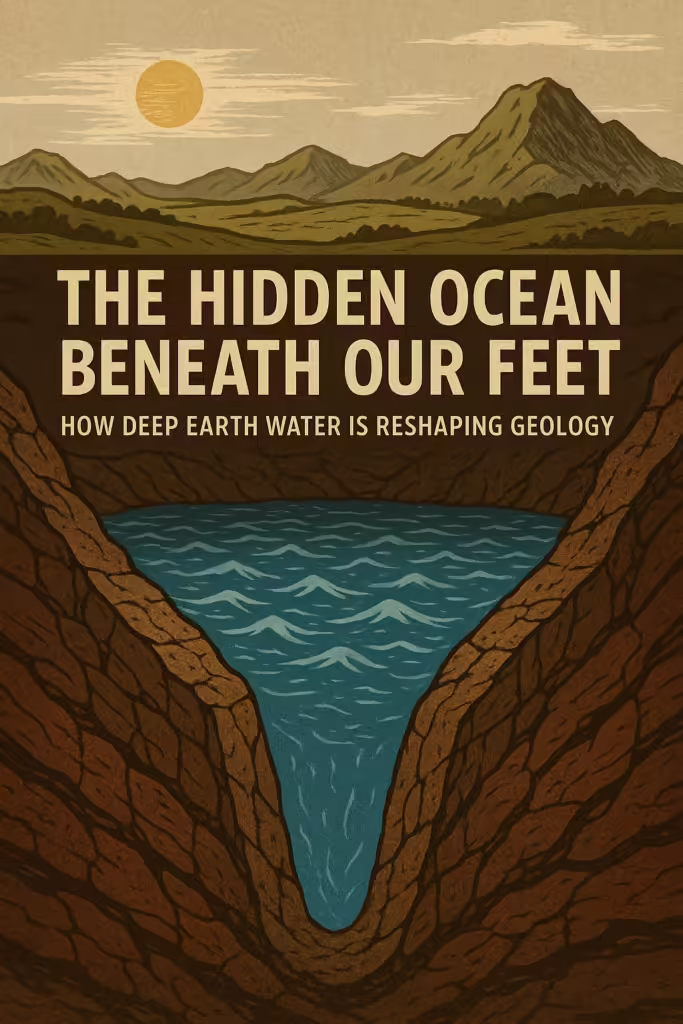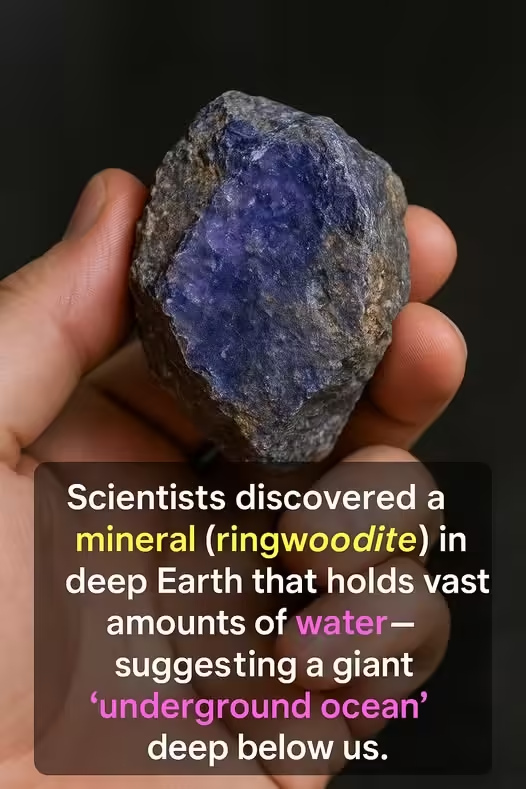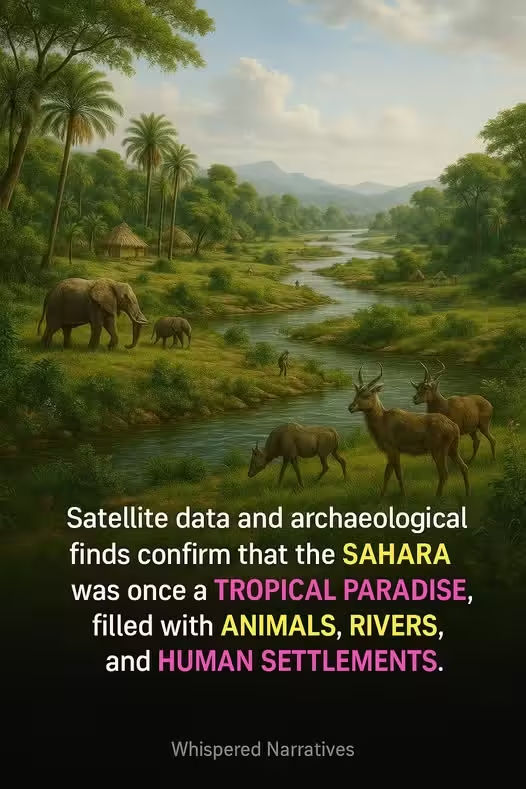
The Hidden Ocean Beneath Our Feet: How Deep Earth Water is Reshaping Geology
When we think of Earth’s oceans, we picture vast blue expanses—Pacific, Atlantic, Indian, Arctic, and Southern—teeming with marine life and stretching far beyond the horizon. But in recent years, scientists have uncovered evidence of a different kind of ocean, one that doesn’t roll in waves or reflect the sky. Instead, this hidden ocean exists hundreds of kilometers beneath the Earth’s surface, locked within the crystal structure of minerals in the mantle.
This deep reservoir, found between 400 to 600 kilometers below ground, isn’t made of free-flowing water. Instead, it’s bound within the atomic framework of minerals like ringwoodite, a high-pressure form of olivine. Though not liquid, this water-rich rock holds immense amounts of H₂O—enough, by some estimates, to rival or even exceed the volume of water in all of Earth’s surface oceans combined.
The discovery of this subterranean water source has revolutionized our understanding of Earth’s geology and hydrology. For centuries, the concept of the water cycle was limited to familiar processes: evaporation from oceans and lakes, condensation into clouds, precipitation as rain and snow, and runoff into rivers that lead back to the sea. But the hidden ocean reveals a far deeper and more complex water cycle—one that extends deep into the Earth’s mantle and may have been active for billions of years.
The Discovery That Changed Everything
The idea of water existing deep within Earth’s mantle has been around for decades, but definitive proof came only recently. In 2014, a team of scientists led by geophysicist Steven Jacobsen made a groundbreaking discovery: a sample of ringwoodite trapped inside a diamond that had formed more than 500 kilometers beneath Earth’s surface. This rare blue mineral had never been seen at the surface before, and analysis showed it contained about 1.5% water by weight—not as liquid, but as hydroxide ions embedded in the mineral’s structure.
This finding was significant not just for its novelty, but for what it implied. If ringwoodite at those depths contains water, and if the mantle transition zone (between 410 and 660 kilometers deep) is rich in this mineral, then the amount of water stored in this zone could be enormous—possibly three times the volume of all surface oceans combined.
For scientists, this revelation opened the door to a new frontier in Earth science.
Water’s Role Deep Within the Earth
Water in the deep mantle isn’t there by accident. Over billions of years, subduction—the process by which oceanic plates slide beneath continental plates—has dragged water-rich sediments and hydrated crust into the Earth’s interior. Once deep enough, this water gets locked into minerals like ringwoodite and wadsleyite under immense pressure and temperature conditions.
But the water doesn’t just sit there. It plays an active and essential role in shaping the planet’s geology. Deep water lowers the melting point of mantle rocks, aiding in the formation of magma. This, in turn, feeds volcanic activity at the surface. It also affects the movement and behavior of tectonic plates, helping to drive the forces behind earthquakes and mountain formation.
Water, even in its bound state, becomes a geological lubricant—a key player in the dynamic system that makes Earth a living, shifting planet.
A Missing Piece in the Puzzle of Earth’s Oceans
One of the most profound implications of the hidden ocean is its potential connection to the origin of surface water. For decades, scientists have debated where Earth’s oceans came from. The leading theories included cometary delivery during the early bombardment phase of Earth’s history or outgassing from volcanic activity.
But the presence of water deep within the mantle suggests a third possibility: that water may have been part of Earth’s original formation, stored deep within its rocky interior and only later released to the surface. As mantle plumes rise and decompression occurs, some of this deep water may be released through volcanic eruptions, contributing to the replenishment and expansion of surface water over geological timescales.
If true, this would mean that Earth’s oceans are not just a surface feature, but the result of deep and ongoing planetary processes—processes we are only beginning to understand.
Changing the Way We Think About Earth
The discovery of deep mantle water has profound consequences for the way we think about Earth and its systems. It forces us to revise long-held assumptions and consider the planet as a more integrated and complex system. It also underscores how much we still don’t know. After all, we’ve explored only the shallowest parts of Earth’s crust, and direct sampling of the mantle remains beyond our current technological capabilities.
This realization also fuels speculation about similar processes on other planets. If Earth has a hidden ocean locked within its minerals, could the same be true for other rocky worlds like Mars or Venus? Could deep water storage influence the potential habitability of exoplanets? These questions point to an exciting frontier in planetary science.
The Hidden Ocean and the Future of Research
Moving forward, the study of deep Earth water is becoming a major area of interest in geophysics and geochemistry. Researchers are using seismic imaging, high-pressure lab experiments, and computer modeling to better understand how water behaves at extreme depths and temperatures. They’re also examining diamonds and volcanic rocks for more clues about what lies beneath our feet.
Understanding the deep water cycle isn’t just an academic exercise—it has practical implications too. Insights into how water influences magma formation could improve volcanic hazard predictions. Knowledge of how water affects plate tectonics might one day help us forecast major earthquakes more accurately.
And perhaps most importantly, studying the hidden ocean reminds us of the interconnectedness of Earth’s systems—from the deepest mantle to the highest cloud.
Conclusion: A World Within
The hidden ocean deep beneath Earth’s surface is one of the most fascinating scientific discoveries of the 21st century. Though invisible and locked away in solid rock, its influence is vast—shaping the surface we live on, fueling geological activity, and possibly even helping to create the oceans that sustain life.
As our understanding deepens, so too does our sense of wonder. Earth, it turns out, is not just a water world on the surface. It’s a water world all the way down.


